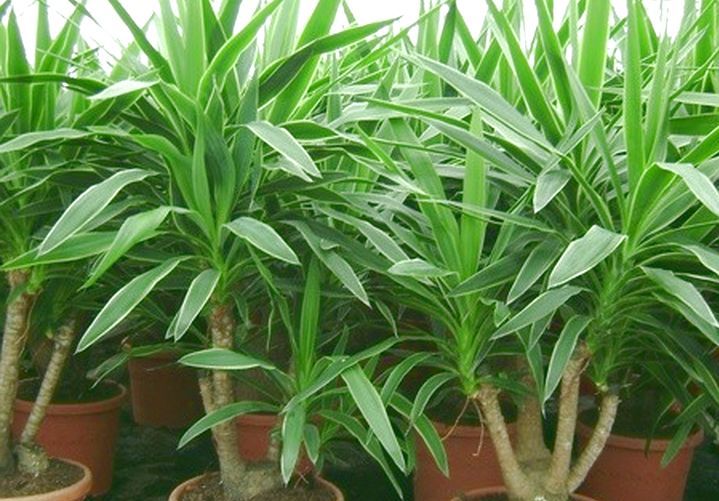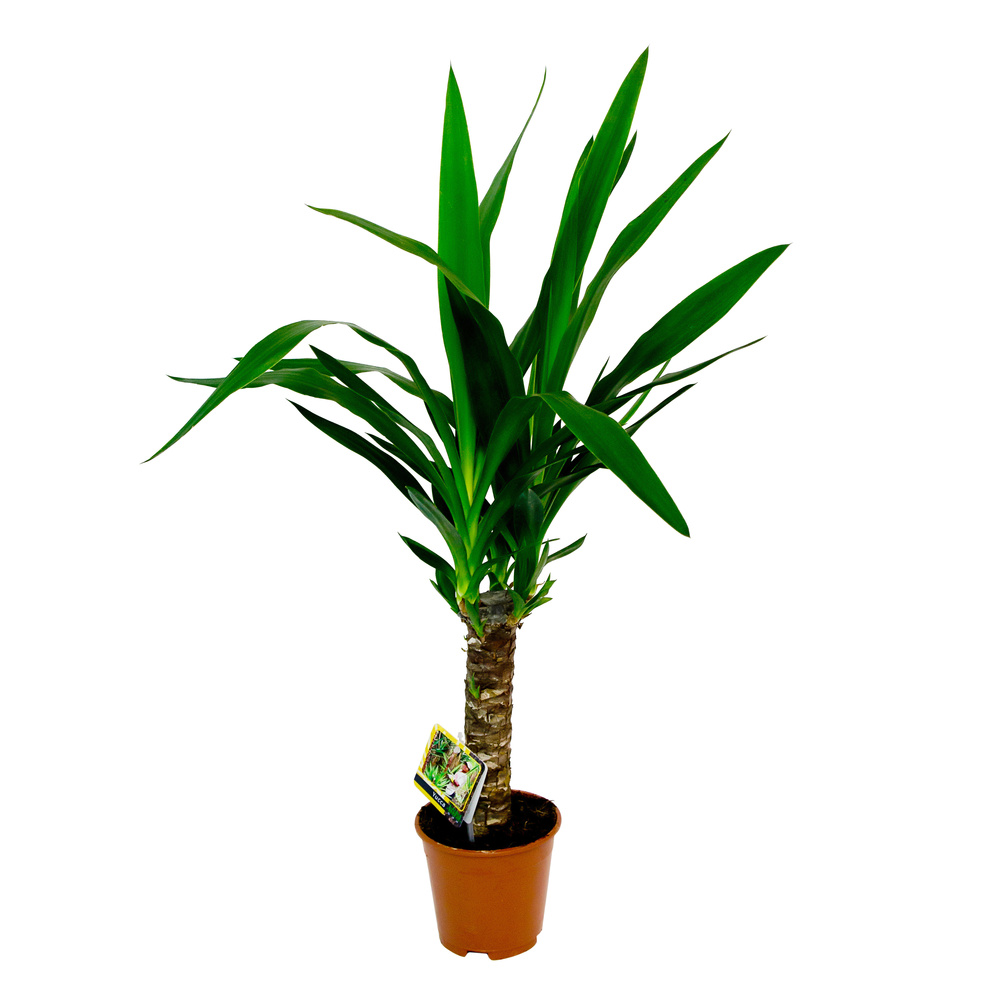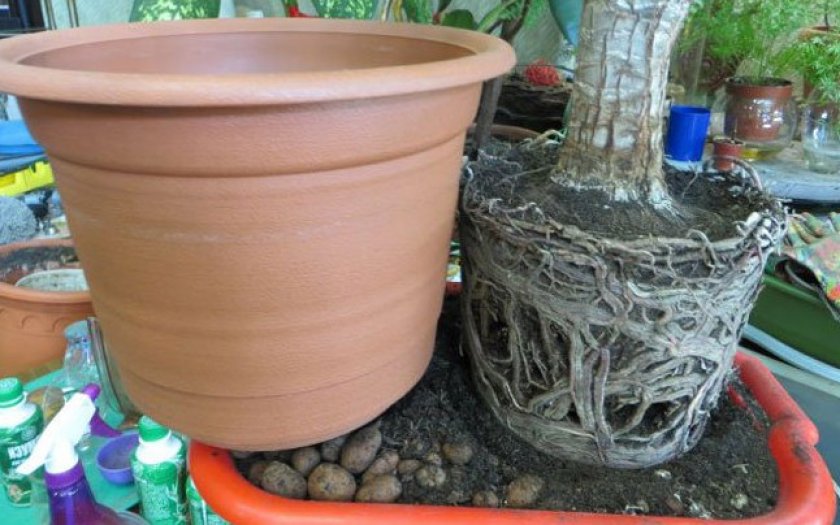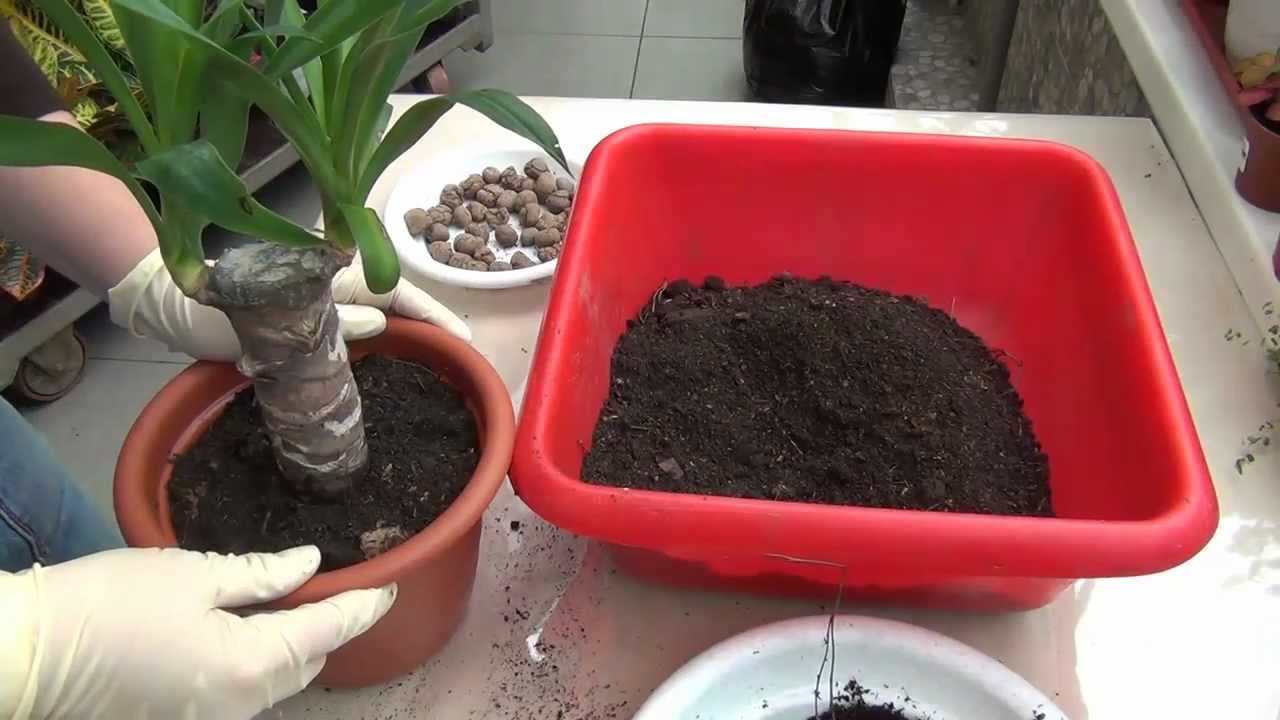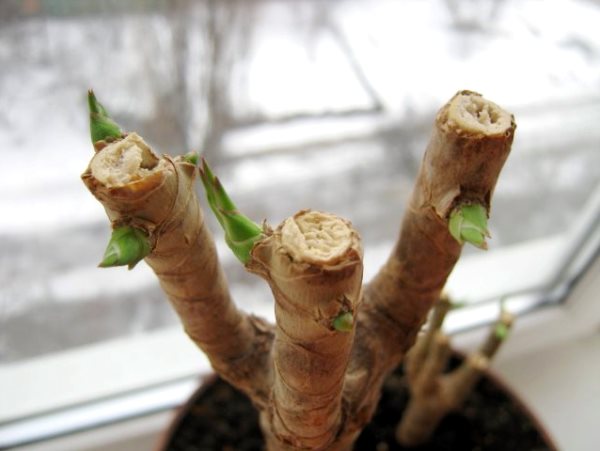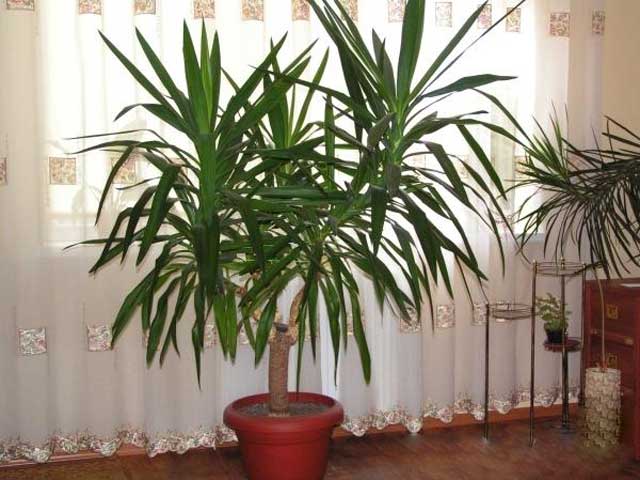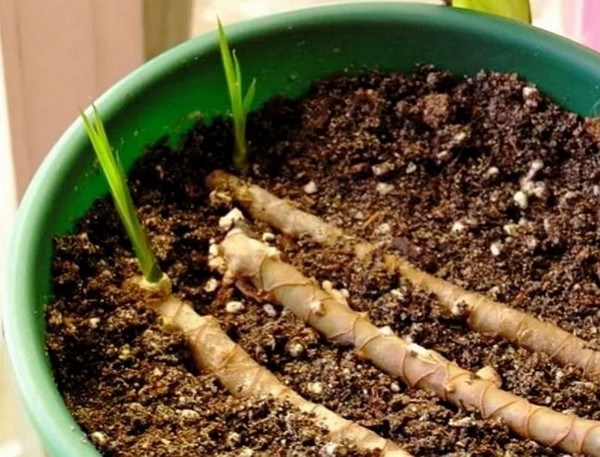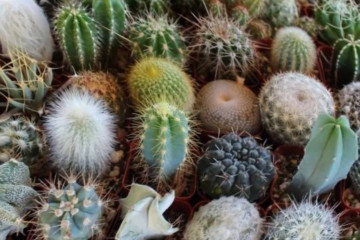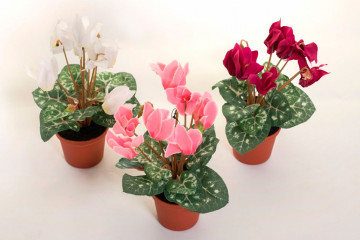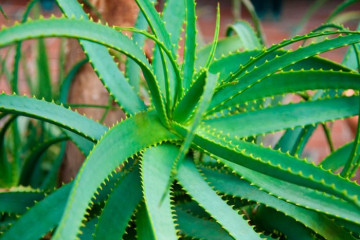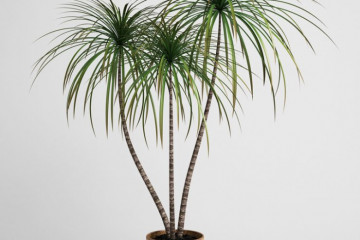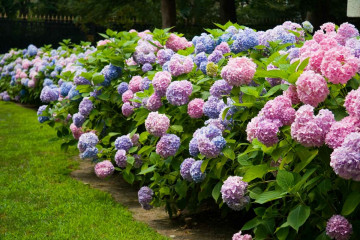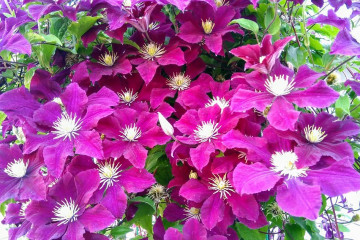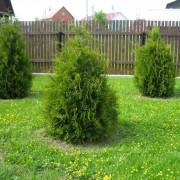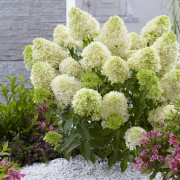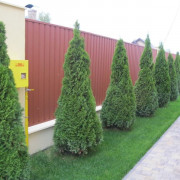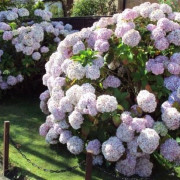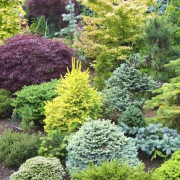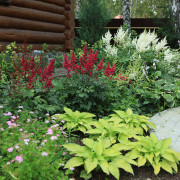How to transplant a yucca: land selection and pruning options
The decorative tropical tree is firmly established in the apartments of Russians. Novice flower growers consider it a kind of dracaena - they have lush, spreading tops very much alike. To grow a beautiful fake palm tree, you need to know how to transplant a yucca and provide it with proper care. It is important to take into account the peculiarities of the development of this exotic.
The need for transplanting and pruning
Yucca grows slowly, it takes several years before it looks like a small tree. This does not mean that the plant should be kept in one container for a long time.
A young yucca needs an annual transplant. This stimulates the strengthening of the root system, due to which the trunk develops more actively. Moving to a more spacious pot has a positive effect on the foliage - each time the crown becomes more luxuriant.
If the yucca is not transplanted in time, it will become uncomfortable in a cramped vessel. In the best case, the palm tree will stop growing, in the worst case, it will get sick.
The procedure for the newly purchased yucca is especially necessary. She can appear in the house at any time of the year. Do not wait for spring to change the pot for the plant.
In such a situation, they are guided by arguments:
- store soil is a mixture of peat and sand, more intended for transporting a plant, in no way for its development;
- commercially available flowers are usually placed in soft small containers to restrict plant development;
- changing the environment, it is difficult for yucca to adapt to a new climate if it remains in a cramped pot with a substrate that is poorly saturated with nutrients.
Sometimes an unplanned transplant is required when the plant begins to ache. In such a situation, it is important to completely replace the soil and take a new pot.
They also regulate the development of yucca by another procedure - pruning. In this case, the goal is the opposite. As soon as the yucca reaches 6 cm in diameter, they begin to control further growth and form a crown.
Home transplant
In order for the yucca to quickly take root in a new place, the transplant begins with a preparatory moment. It is important to choose a suitable container, take into account what kind of soil the plant needs. Under these conditions, adaptation will occur comfortably.
Pot and soil selection
The planned relocation of yucca is carried out in the spring, so that the grower has time to stock up on a suitable substrate and a new pot. In the preparatory moment, it is important to take into account the peculiarities of the development of yucca.
Suitable capacity
The decorative exotic does not like waterlogged soil, so the new container should have a large drain hole at the bottom.
You should pay attention to other requirements:
- the pot should be 2-3 cm wider than the diameter of the underground part of the flower;
- for stability, proportional ratios of parameters are taken into account: the depth of the container is 2 times the inner diameter;
- the pot material should not bend under the pressure of the growing roots.
You can choose plastic containers if they have thick, sturdy walls. The best option is ceramic (clay). Such a pot does not deform and perfectly absorbs excess moisture.
Substrate preparation
Yucca can be moved to a new pot with an earthen clod if the soil is still nutrient-dense. Experienced growers recommend completely renewing the soil by choosing a neutral peat mixture.
If it is difficult for beginners to properly prepare the soil, you can buy soil for yucca at a flower shop. When self-mixing, it is important to maintain the proportional ratio of the components.
Soil options for yucca
| Structure | Proportions |
|---|---|
| Universal substrate and sand | 7:3 |
| Compost, leaf and turf soil, sand | 1:2:2:2 |
| Sand, leafy soil, turf | 2:2:3 |
You can also add 2 parts of coarse sand, 1 part of peat and humus to 3 parts of sod soil. Instead of sand in these compositions, other disintegrants are sometimes used - vermiculite, perlite.
Transferring to another pot
Not everyone knows how to properly transplant a yucca at home.
In order not to harm the plant, you need to clearly follow the step-by-step actions:
- The yucca is carefully removed from the pot and placed in a container of water. It is important that the liquid completely covers the roots.
- The false palm is left for an hour so that the water will wash away all the earth.
- The bottom sheets are cut with a sharp blade. This will provide the plant with a comfortable adaptation.
- The tree is removed from the container and placed in another - with clean water. The procedure is repeated several times to completely get rid of the old earth. The roots are washed carefully, without effort, trying not to break them.
- A layer of drainage is poured into the prepared pot (expanded clay, gravel, river pebbles, brick crushed into crumbs, small pieces of foam) 3 cm thick.
- The drainage is sprinkled with an earthen substrate so that the pot is 2/3 full.
- A palm is placed in the middle of the container, evenly distributing the roots along the ground.
- The rest of the substrate is poured, shaking the container from time to time - there should be no air voids in the soil.
- The transplanted tree is watered abundantly.
With the annual resettlement of a young yucca, the first 2 stages are skipped. The substrate has not yet had time to be depleted in useful substances, so the plant can be loaded along with an earthen lump. Before removing the yucca from the old container, remove not only the bottom plates, but also all sluggish, yellow, damaged leaves.
When an unplanned situation arises - rotting of the roots, a small adjustment is made to the technique of how to transplant yucca:
- rotted parts of the root system are completely cut off;
- the sections are powdered with crushed activated carbon or wood ash;
- watering is carried out on the 4th day, so that the sections have time to dry out, otherwise infection with fungal spores is possible.
The fact that an urgent transplant is needed can be judged by the state of the yucca. Her trunk will soften, or leaves will begin to fall off en masse.
Pruning and transplanting an appendix
When the roots cannot be saved, the aerial part of the plant is used for relocation. You need to know how to properly cut and transplant the yucca palm process in order to give the flower a second life.
Let's apply this method to a plant that has managed to give lateral layers. The baby is cut so that a 10 cm long stem remains under the foliage.
Then they act according to this recipe:
- 2 hours the shoot is kept on the table to dry the cut;
- the damaged area is treated with charcoal;
- then the layering is immersed in wet sand, vermiculite (perlite).
The fastest way to root is in a container of water. Since yucca babies are not willingly transplanted, they should be stimulated with "Zircon" or "Kornevin".
Plant pruning
A small palm tree with a single rosette looks beautiful. But as soon as the tree stretches out, all presentability is lost somewhere. In this case, you should not think about whether the yucca can be cut off - the procedure is necessary to form a beautiful crown.
The second reason for taking this measure is to slow down the growth of the flower.Under natural conditions, a false palm is capable of reaching 4 m. In apartments, the limit is 2.5 m. A tree resting against the ceiling not only looks ugly, but can get sick and even break.
Trimming the stem will stun growth and stimulate the formation of new (lateral) rosettes. The trimmed part is an excellent breeding material for yucca.
How to trim properly
The pruning technique has its own tricks. If they are not taken into account, the plant may die.
Therefore, in the process, the following recommendations are adhered to:
- the procedure is carried out at the end of winter, when the yucca has not yet managed to get out of a state of dormancy;
- you cannot resort to such manipulations if the tree has not rested properly, and has not gained strength; therefore, from November to the end of February, yucca is kept away from sunlight at a temperature of + 10 ° C;
- after the procedure, the yucca is not watered for 2-3 weeks, so that the healing of the sections is easier; but the plant needs a supply of moisture for this period, therefore, abundant watering is carried out 2 days before pruning;
- since the remaining stump will no longer grow, but will become a support for new shoots, it must be strong enough; therefore, it is worth waiting for the trunk diameter to reach 5 cm;
- after pruning, a stump with a height of 20-50 cm is left in a flower pot;
- on the cut off top under the foliage there must be a lignified piece with a length of at least 10 cm;
- when shortening the yucca, you can not break it off; in work they use a sharp knife, garden shears or pruning shears, holding the crown with the other hand;
- all sections after 2 hours are treated with activated charcoal, garden putty, cinnamon, or filled with paraffin.
The yucca remaining in the pot is kept in a warm room away from direct sunlight. For 3-4 weeks it is not watered, the soil is not fertilized. Resting will help the yucca to get out of stress faster.
The cut trunk is cut and rooted. The top is also used to plant a new pot.
Pruning for branching
A beginner can also form a beautiful palm tree, knowing how to cut the yucca correctly. This business is troublesome and requires special attention to its implementation. Pruning once will not produce a beautiful, lush crown. Over time, the elongated trunk will remain bare.
In order for the yucca to branch well, first the upper section of the trunk is sprayed with "Epin" or the side scales are smeared with cytokinin paste (to stimulate dormant buds to grow).
When shoots appear and begin to develop, some are removed, leaving from 2 to 5 sockets on the trunk (on a thin one - no more than 3 pieces). Having given new branches to grow and stiffen, they are also cut off, like the main trunk. So over time, the yucca will turn into a low tree with a beautiful dense branching crown.
Trunk pruning and grafting
If the cut off stem is long enough, it is divided into parts for reproduction. Slices dried and treated with a disinfectant are rooted in one of the ways.
Yucca cuttings
| Way | Features of the |
| Horizontal | The cut is immersed halfway in wet sand so that a few dormant buds remain on the surface. When shoots appear on the handle, it is cut according to the number of shoots and planted in separate pots in the standard way. |
| Vertical | A section of the trunk is placed in a lower cut into a vessel with water. You can also bury the stalk in wet sand or vermiculite. After waiting for the thread roots to sprout at the bottom of the segment and reach 1 cm, and a green shoot appears at the top (and it will be the only one), the seedling is transferred to a permanent pot |
Cutting is a lengthy process and requires patience. It will take at least a month to form the roots.
Further care
Planting room yucca and subsequent care are related activities. Even the slightest violation of agricultural technology will damage the plant. The palm tree is unpretentious to the climate, therefore, it is not necessary to specially monitor the humidity of the air. The main modes of agricultural technology are standard for a succulent.
Soil and watering
The soil in the pot is kept semi-dry to avoid root rot. You can periodically pour water into the pan, the plant will take as much as it needs. Liquid should not get stuck there.
To adjust the irrigation regime, many factors are taken into account:
- plant age and size;
- season and weather outside the window;
- even the material the pot is made of.
In summer, the yucca is watered as soon as the soil dries out to a depth of 5 cm. When the air temperature drops to + 20 ° C, water procedures are carried out 1 time in 7-10 days. If the yucca is sent to a cool room to rest, the soil is slightly moistened once a month.
The volume of full watering is commensurate with the amount of soil in the pot. For a 5-liter container, take 1 liter of purified (settled) water.
As for the material, yucca in plastic should be watered less frequently. The porous structure of the clay pot provides additional drainage, so the soil dries out faster.
Top dressing
The older the yucca gets, the more nutrition it needs. The plant is fed once every 2-3 weeks, using universal preparations for palm, but they do it at certain periods.
You shouldn't fertilize:
- if the plant has recently been pruned;
- some time after transplant;
- when the palm is at rest (autumn, winter).
Top dressing is necessary only in the active growth phase. If at this time the yucca is sick, do not overload it with mineral and organic substances.
In order for the yucca flower to develop normally, home care, transplantation is carried out according to all the rules. You should not expect flowering from a houseplant, but a beautifully formed crown will also become an interior decoration.
